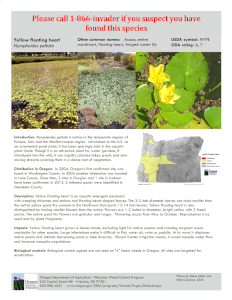2022 MID-WILLAMETTE AQUATIC EDRR SURVEY AND TREATMENT GRANT
This grant funded by Oregon State Weed Board to survey and control aquatic invasive plant species that threaten fish and wildlife habitat in a local reach of the Willamette River spanning 22.75 miles from Keizer Rapids Park in Polk/Marion County, downstream to San Salvador Park in Yamhill/Marion County. Treatment will occur for known populations of Garden Yellow Loosestrife and other Early Detection Rapid Response species found. Loosestrife is only known to occur in the Willamette River between Spring Valley Access and Grand Island within this project area. Isolated, small patches of Ludwigia will also be treated. The total project area will be 1,100 total survey acres and 0.266 gross treatment acres.
Contracted surveys and herbicide treatments by canoe will be conducted in tandem by Willamette Riverkeeper and Integrated Resource Management to allow for immediate, on-site treatment of infestations observed. Members of our local aquatic weed partnership will also participate in surveying, including staff from Yamhill/Marion/Polk SWCDs, Greater Yamhill Watershed Council, and ODA. Riverkeeper will produce a GPS dataset and report, which will be used by partners to guide follow-up treatment needs, and plan for future weed control collaborations. OPRD will provide a jet-boat and crew for a follow-up survey/treatment day.
Partners will conduct outreach to riverside landowners, including a coordinated mailer to empower landowners with tools to ID/report AIS and promote programs available from their local conservation organization. Partner staff will provide technical assistance to respondents, as well as follow-up outreach for any private infestations observed. This project area is strategically contiguous with upstream surveys and treatments from Eugene to Keizer occurring in coordination with Willamette Riverkeeper and Benton SWCD.
Invasive Species
Garden Yellow Loosestrife (Lysimachia vulgaris)
This Class A-T invasive has been found in small populations near Wheatland ferry and was treated in 2021. It is a riparian species that can live in shallow water or up above the waterline. This grant expands the survey and treatment area to more completely cover the area and check for new populations downstream of last years effort. For more information, click on the image to the right.
Yellow Floating Heart (Nymphoides peltata)
This Class A-T invasive is an emergent aquatic plant that grows in such dense mats of floating vegetation that it blocks light for other aquatic organisms. For more information, click on the image to the right.
Water Primrose (Ludwigia spp)
This B-T classified weed is another shallow water plant that forms dense floating mats that can dominate waterways and clog irrigation equipment. For more information, click on the image to the right.












